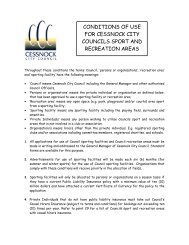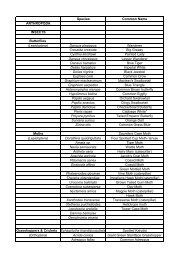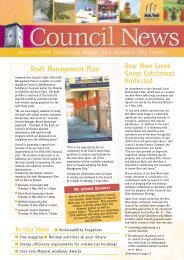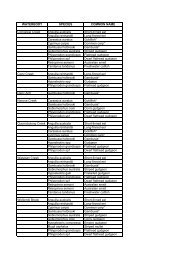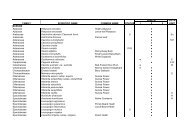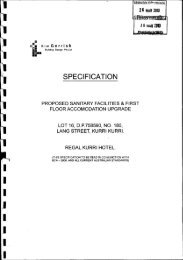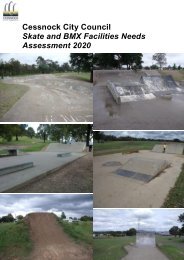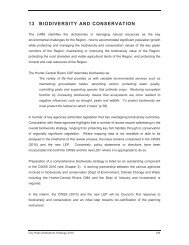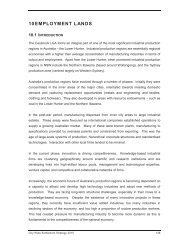E.8: BOW WOW CREEK GORGE - Cessnock City Council
E.8: BOW WOW CREEK GORGE - Cessnock City Council
E.8: BOW WOW CREEK GORGE - Cessnock City Council
Create successful ePaper yourself
Turn your PDF publications into a flip-book with our unique Google optimized e-Paper software.
Part E – Specific Areas<br />
Chapter 8: Bow Wow Creek Gorge<br />
APPENDIX 1<br />
Bow Wow Creek Gorge Catchment Habitat Corridors & Revegetation Guidelines<br />
<strong>Council</strong> is seeking to promote the establishment and enhancement of habitat corridors in Bow<br />
Wow Creek Gorge Catchment generally in accordance with locations and details specified in this<br />
Appendix. Other mass plantings are also being encouraged in strategic locations.<br />
Objectives<br />
• To enhance native fauna habitat and conserve the biodiversity of the Bow Wow Creek<br />
Gorge.<br />
• To ensure Bow Wow Creek Gorge does not become isolated from surrounding remnant<br />
bushland to the north and south.<br />
• To promote a more sustainable environment.<br />
DEVELOPMENT INCENTIVES AND MAINTENANCE<br />
• As detailed in the provisions of its environmental planning instrument, the <strong>Council</strong> may<br />
consent to increased tourist development densities within Zone No. 1(bwc) where a<br />
proposal seeks to fully comply with the requirements for maintenance of existing habitat<br />
corridors, (see Figure 1), or where a proposal seeks to establish and maintain a minimum<br />
of 900 native trees or shrubs per tourist accommodation unit.<br />
Notes:<br />
1. The requirements for the maintenance of existing habitat corridors applies only to sites<br />
that are fully vegetated, in all other cases supplementary plantings, as discussed in 2<br />
below, will be required to qualify for increased tourist development densities.<br />
2. Where corridors partially exist within a property, the density outlined above can be<br />
achieved through appropriate supplementation of native vegetation (determined on-merit<br />
due to species selection and associated sizes) and where such total areas are maintained<br />
in perpetuity as outlined below.<br />
• Where an application seeks to develop tourist accommodation buildings with habitat<br />
enhancement, details of the proposed planting must be clearly specified in the application<br />
(both within plans and in the text accompanying the application), including proposed ground<br />
preparation, species planting and maintenance and fencing details. This Appendix<br />
provides further detail concerning habitat enhancement and information to be submitted<br />
with applications.<br />
• Consents issued on the basis of habitat enhancement will include specific conditions<br />
relating to the continued maintenance of such habitat, remaining the responsibility of the<br />
land owner, eg. through instruments attached to the title of the property. A refundable<br />
bond or bank guarantee will be required in the order of $3000 per tourist accommodation<br />
unit above the allowable density of tourist accommodation units under Columns 1 and 2.<br />
• The total amount of the bond will be released upon attainment of a 90% establishment rate<br />
within 3 years of the completion of planting activities. A 90% survival rate (of<br />
establishment of planted trees/shrubs) must be achieved at the end of 18 months following<br />
completion of planting activities or at a later date to be agreed upon by <strong>Council</strong> for<br />
environmental reasons such as seasonality and/or drought factors. To be considered<br />
successful at the time of inspection by <strong>Council</strong> staff, all tree plantings must have achieved<br />
CESSNOCK DEVELOPMENT CONTROL PLAN <strong>E.8</strong>-14



